

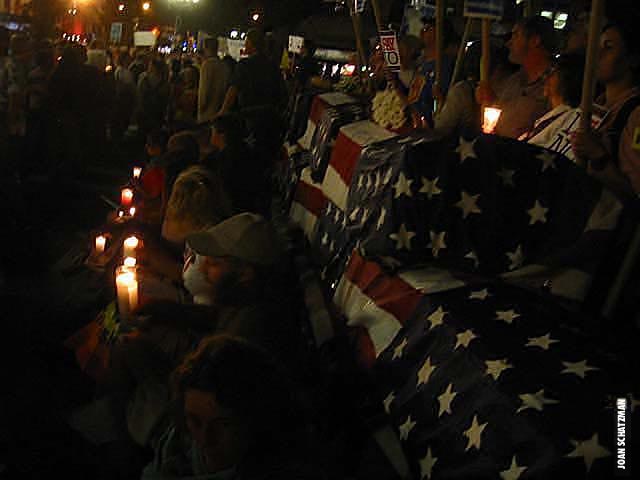
Union Square Vigil for Iraq Dead
Shortly after one p.m. on Saturday, August 28, 2004, three carloads of University of Virginia students and private citizens departed Charlottesville, bound for New York City. We were going to protest the war in Iraq and March For Peace and Justice . That night, I called the folks from an Italian restaurant near Macdougal St., where I was staying. Mom said, “Don’t throw things at the cops and don’t get arrested, because they will torture you.” Dad said, “Strap a shiv to your leg so you can reach down to get it if you need to.” I assured them it was going to be a peaceful march, and there was no way I’d put myself in harm’s way.
Sunday, August 29
This is the day of the peace march. I had an over-priced breakfast of potato pancakes and coffee down the street from the apartment, at the International Café. I was charged $9 for three cups of coffee. I thought the second two cups were merely refills, silly me.
Properly fortified, I walked from 4th and Houston to 14th and 7th Ave, where the march was forming. The staging area was a large rectangle of several streets spanning 5th-9th Ave and 14th-22nd. Somehow I ended up right in front of the starting line. Michael Moore and, of course, Jesse Jackson were front and center.

Lead-off Banner UFPJ
I liked being ahead of the throng. I talked to two clean-cut guys recently graduated from college, who turned out to be guests of Republicans delegates. They said they were there to see what was going on. Did they realize they were adding to the body count? They bought the whole Bush agenda hook, line, and sinker, parroting presidential sloganeering. One declared that his new insurance job was created by Bush’s tax cuts.
The city was spending unprecedented amounts of money securing itself in preparation for the peace march and the Republican National Convention. The staging area and march route were lined with miles of metal barricades for crowd control, the police were helmeted, armed, and ubiquitous.
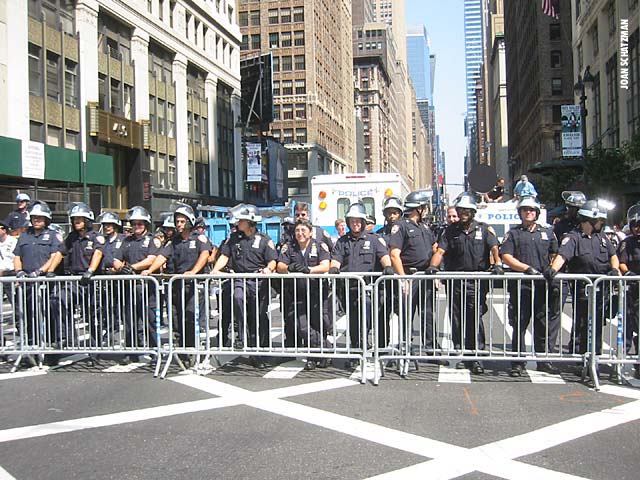
Barricading 7thAve
After a long wrangle in the courts, United For Peace and Justice (UFPJ), the march organizers, had been denied a Permit to rally in Central Park after the march. Barricades and an impressive line up of N.Y.P.D. forced the march to u-turn at 34th and head south down 6th Ave toward Union Square. I wanted to go to Central Park anyway after the march, so I crossed over the metal barricades and stood in front of Macy’s.
For the next five hours I watched 500,000 marchers stream by.
Around three p.m., I saw smoke coming from 7th Ave and Madison Square Garden. A small group of activists had set fire to a papier-mâché dragon.
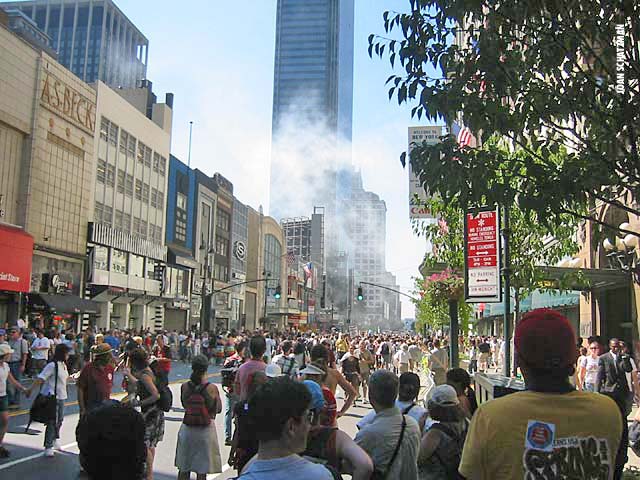
Dragon Smoke
Minutes later, cops came running up 34th St with their batons flailing. They moved in on a couple of guys and beat them to the ground. They themselves were immediately surrounded by the media and marchers with cameras rolling.
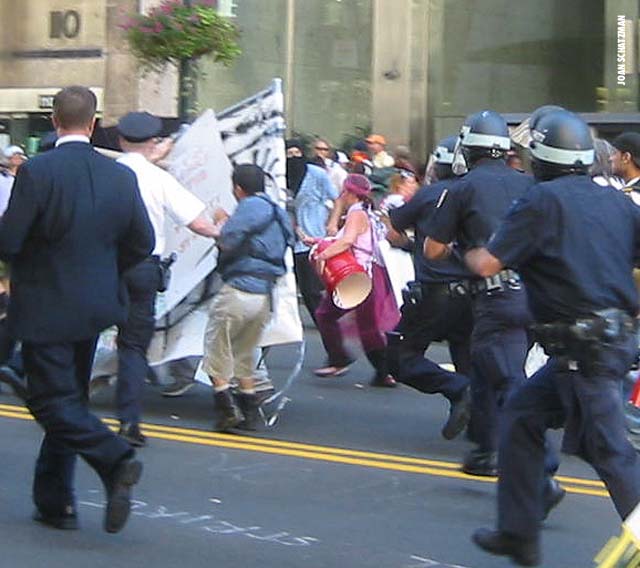
Red Drum
Within a minute, 250 cops in riot helmets, loaded with plastic handcuffs created an impenetrable ring around the tussle. Boos and chants erupted from the crowd to let them go. A second tussle sprung up a hundred yards away. The police cavalry was brought forward. Amazingly, the captures and arrests took place in twenty minutes. The march resumed as though nothing had happened. No more flare-ups were reported for the rest of the day.

Cop Cavalry
The dramatic and emotional high point of the march was 4000 people carrying 1000 flag-draped coffins.

Coffins
I met an older couple who lived on the Upper East Side. Morty, the husband, was plugged into his Walkman, listening to Air America, getting up-to-the-minute peace march news. Each time his wife asked him a question, he’d say, “What?” and pull out the ear piece. He was an architect who designs prisons. They took me under their wing after we stood and chatted for three hours. They escorted me to the subway and taught me how to buy a metro card. We took the F train uptown and parted ways at 63rd and Lexington. There was only a very tiny peace-march presence in Central Park. My guess was the march was so big and took so long, that there wasn’t enough time to make it all the way back uptown. I bought a 24oz Corona and headed over to the park for three vender hot dogs and a nap on the grass.
Monday, August 30
I found a cheap breakfast shop next door to the Blue Note, where, for a buck and a half each, I got coffee and a bagel.
WINA, a Charlottesville AM radio station, had asked if I’d like to give live reports over the telephone describing the peach march and R.N.C.-related protest activities. You bet.
I went on the air at 9:10 a.m. Dick Mountjoy, the morning DJ, asked if I thought 500,000 peace marchers were going to make a difference. “Yes,” I said, “but mostly to the already converted, because the current administration has a knack for dismissing large marches as just another focus group. For example, Bush dismissed 10 million peace marchers in Oct of 2002 in the run up to the war.”
I was at the ’68 Democratic convention in Chicago demonstrating for peace in Vietnam. Mountjoy asked me to compare and contrast the two conventions. I said the cops in 1968 Chicago were ignorant Neanderthals. The C.T.A. bus drivers were on strike. Bobby Kennedy, and Martin Luther King had just been assassinated in the spring. The people were angry. In contrast, cops have become better trained. The N.Y.C. cops were disciplined and respectful. Marchers want to be peaceful and they want their voice heard.
After the interview, I crawled uptown on the 6th Avenue bus to Times Square. It took forty-five minutes to go a couple of miles, because of the R.N.C. traffic. Times Square teemed with people walking in every direction. Electronic signs pulsed out their messages, traffic and construction noise deafened the ear. Hawkers stood at the corners selling everything, including cruise ship tickets on the Circle Line. I charged a three-hour circumnavigation cruise for $26 on their satellite credit-card reader. (Isn’t modern technology wonderful?) It was only a four-block walk down to the pier, but a mighty long four blocks it was.
It was a perfect day to be on the water. The sun peeked out between huge weather clouds as they marched across the sky in an ever-changing skyscape. The temperature was just right, with only a light breeze. We shoved off, heading south, a little after noon. Going around the island is a good way to get oriented. I located the U.N., where I would be later on that evening, and the Cloisters, where I would go the next day.
At 3:30pm I grabbed a 42nd Street cross-town bus to the U.N. Forty-Second Street was divided into three zones, two lanes each for east and west traffic and two lanes up the middle for emergency and cop vehicles. We were let off in front of my favorite skyscraper, the Chrysler Building. I joined up with the Billionaires for Bush and walked to Dag Hammarskjöld Square, across First Avenue from the U.N. The area quickly filled up and spilled over with people converging from all directions to participate in a rally for the “People’s Economic Human Rights Campaign.” The Billionaires for Bush is a tongue-in-cheek collection of people festooned in Salvation Army tuxedos and prom dresses. They shouted out slogans like “More, More, More,” and, “”We Want Slave Labor and We Want It Now.” Other groups like The Pink Slip Ladies and Axis of Eve ladies shouted “Give Bush the Pink Slip” and “Bush Stay Out Of My Bush.”
The swelling crowds made the nervous cops herd everybody off the sidewalks and out of a small public park near Hammarskjöld Square. Even so, the crowd remained jovial. After the speeches and a mass pledge to remain peaceful, 10,000 people flowed up 47th to 2nd Ave in an unpermitted march. The cops chose to allow this spontaneous march. In a game of city-streets chess, the crowds and the cops tried to out-flank each other along the impromptu route.
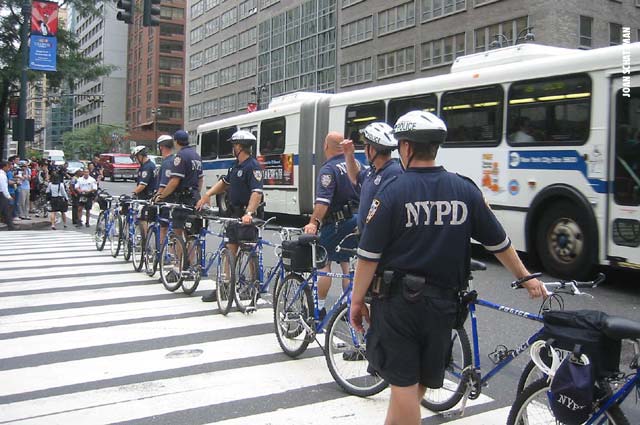
Cops On Bikes

Scooter Cops
Scooter cops formed a moving fence line, keeping the marchers to one half of the street. Brigades of bicycle cops used their bikes to barricade the intersections, preventing the marchers from making any turns toward the Garden. The press was balled up at the front of the marchers, ready to pounce if any violence broke out. Undercover cops shadowed the marchers from the sidewalks. I said to one undercover cop wearing shorts and an overhanging t-shirt, doing a lousy job disguising his gun, “You look so obvious.” He said, “I got nothing to hide.” We fell into an easy conversation once I congratulated him and the N.Y.P.D. on the good job they were doing. He confirmed there were 500,000 at Sunday’s Peace March, and only around 200 arrests.
I spied some Republican delegates emerging from a hotel on 2nd Ave. They were easy to spot with their R.N.C. delegate bling-bling. Shock registered on their faces when they saw and heard the protesters walking in front of their hotel. They cautioned each other to remove any signs or symbols that would give them away as Republicans. Were they ashamed? I over heard a male delegate tell a video documentarian about the marchers, “I don’t believe in socialism.” He never mentioned the “elephant in the living room”: the war in Iraq.
The march turned north at 23rd and Broadway and got to within a few blocks of the Garden, where, after some arrests, the people dispersed.
Tuesday, August 31
The outpouring of offers of assistance from New Yorkers in the lead-up to the Peace March was tremendous. Counterconvention.com, among many web sites, posted housing offered by people from the five boroughs and New Jersey. Mary Leah Weiss had listed her midtown apartment as a free place to stay for out-of- towners coming to march for peace. I was one of the many she wait-listed. She called back to say she was having a pasta dinner on Tuesday for all who had called but couldn’t be accommodated. All I had to do was bring a bottle of wine.
After a sit-down dinner, we each related what motivated us to spend so much money and time coming to march and demonstrate during the R.N.C. The two Canadians came because they saw Bush as more than just the president of the United States. They saw him as president of the world, because any decision his administration makes affects the whole world. The others came because they don’t like the direction Bush is taking the country. I came because my voice is no longer being heard. More than fifty percent of the voting population effectively has no representation in our federal government. It is dangerous in a two-party democracy to have all three branches of government controlled by the same party. To get the attention of the administration because I wanted the war of choice in Iraq to end, I joined a huge group of like-minded people. Too bad, it is reported, that George Bush dismisses us as “focus groups” and doesn’t read the newspapers.
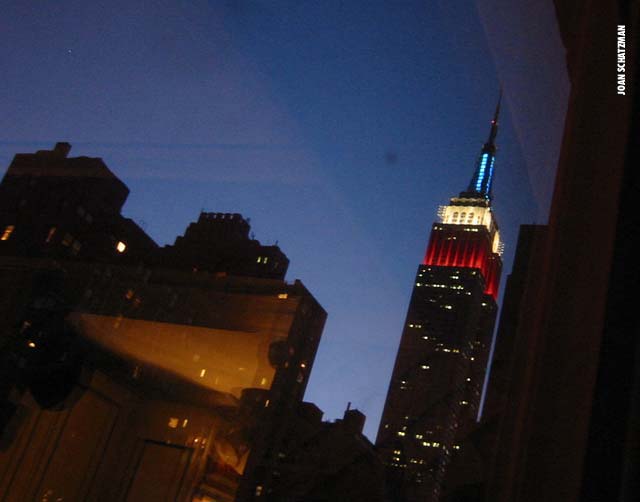
Empire
Wednesday, September 1
In the morning I gave my last report to WINA, then took the #2 bus over to the Brooklyn Botanical Gardens, where I met a friend. Hardly a soul was to be seen except for a handful of cops standing around the restaurant. Garden visitors stayed away in droves when word got out the R.N.C. was hosting a luncheon there. At the last minute the luncheon was canceled. My friend and I had the whole Gardens to ourselves. After walking and enjoying the solitude in a large public place, we found a patch of grass at the cherry esplanade where we could legally sit. We lay on the grass chatting till it was time to eat lunch at the Botanical Terrace Café.
Afterward, we walked over to the Brooklyn Museum and viewed three floors of paintings, decorative arts, and Egyptian treasures. Then I took a train across the Manhattan Bridge train to Union Square, just for a skyline view of the city.
The south stairs of Union Square were arrayed with a thousand pairs of tagged shoes.
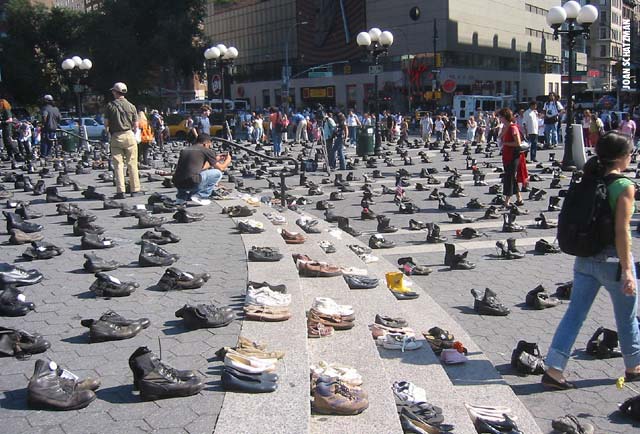
Tagged Shoes
Each tag had the name of someone who has been killed in Iraq since George Bush launched his invasion on March 20, 2003. Spontaneously, people left their own shoes along side the existing ones. The whole display was a symbol of and a tribute to the 16,000 people and more, the organizers said, had so far been killed.
You have to love Americans’ entrepreneurial spirit. All over Union Square, people were hawking, anti war t-shirts, buttons with slogans, bumper stickers, and CDs of George Bush’s words electronically mixed.
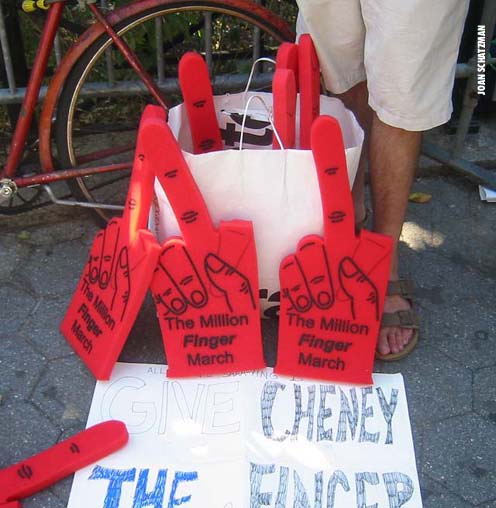
Million Fingers
At six p.m. I took a train down to the Battery to see the Pink Slip Ladies and Axis of Eve rally.
The Pink Slip Ladies want to give George Bush the pink slip. The Axis of Eve wants to expose bush, and register young women to vote. Since these were women showing tits and bush, the male media swarmed the rally, giving lots of coverage to the uncoverage. By employing humor and female ingenuity, these women manipulated the press into giving them lots of photos and column inches in the newspapers.
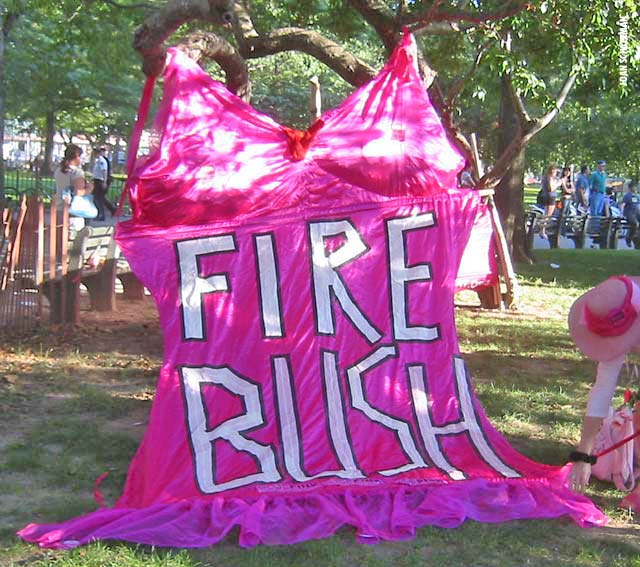
Pink Slip
At seven p.m. I took the #6 train up to the N.O.W. rally in Central Park. The only access the police allowed us was at 90th and 5th Ave. We were herded between blue police sawhorses for nine blocks, until we emerged at the rally venue in the East Meadow.
If there is one thing I hate about New York City, it is no public toilets. And there weren’t any in the park either. The N.O.W. people did provided two well-hidden PortaPotties for 20,000 rally attendees. For two hours, we listened to short impassioned speeches, alternating with spoken and musical performances. At nine p.m., sharp, the police unceremoniously cut the power. Peacefully, the crowd dispersed.
Thursday, September 2
After spending the morning nursing my feet (I was averaging about ten sidewalk miles a day), I walked to Union Square, the default place for protesters to congregate.
Later on I met a friend in midtown. We wanted to go walk by the Union League on 37th and Park and see where Dick Cheney and the Poppy Bushes were staying. There was no mistaking the fact that someone important was staying there, because three very conspicuous, gas guzzling, dark-tinted windowed, black SUVs were parked out front.
Next, we walked over to Macy’s hoping for Republican-delegate sightings.
We walked past Madison Square Garden, but we were not allowed to linger.
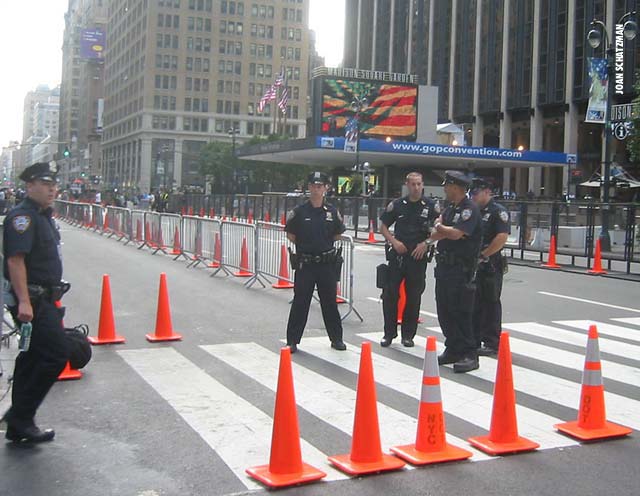
Guarding The Garden
At the cocktail hour, we went to a beer joint called Ginger Man. When it came time to pay the bill, our three barmaids bought one of the rounds. They loved our anti-Bush pins. They wanted to show solidarity.
I returned to Union Square for the candlelight vigil.
Several thousand people assembled to once again deplore the war and honor the dead. Reverend Billy of the Church of Stop Shopping, dressed in a white suit, white collar, and black shirt, chanted the First Amendment through a bull horn as though it were a prayer.
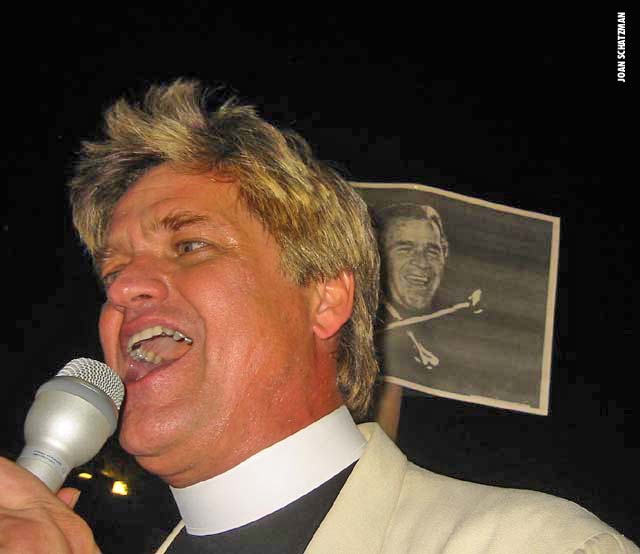
Reverend Billy
The crowd repeated each phase till the First Amendment was committed to memory. Three different parents carried poster-sized pictures of their uniformed children.
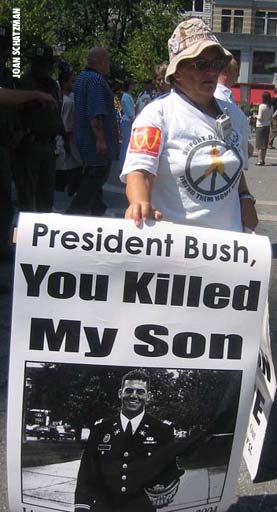
You Killed My Son
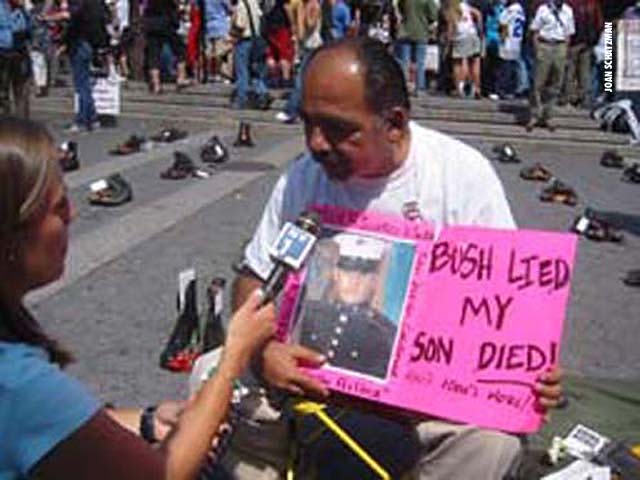
My Son Died
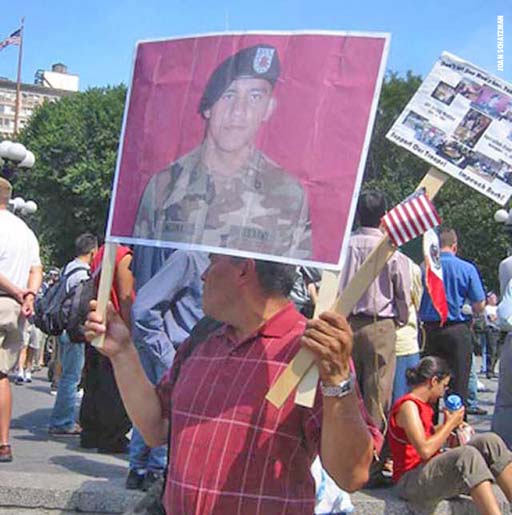
Dead Son
I met two ordinary people who had just been released after being arrested in a police dragnet.
During a spontaneous march on Tuesday, the cops told the marchers to stay in pairs on half of the side walk. The marchers complied. For reasons yet to be revealed, the cops split the group and rounded up a few hundred people with orange plastic netting, including random passers-by. They were carted off to Pier 57, renamed Guantánamo on the Hudson, where they had to sleep on diesel oil-covered floors and were held for more than 24 hours (this was illegal: they had to be processed and released within a day).1 They were charged with unlawful assembling. Ouch.
Throughout the evening I had brief but intense conversations with whomever I happened to be standing near. More often than not the conversations ended with a heart-felt hug.
The common sentiment was: re-defeat Bush and end the war in Iraq.
At the end of the evening I watched George Bush’s acceptance speech on TV. Once again he claimed the war in Iraq and the economy are going well. And Osama bin Ladin remains Osama bin Forgotten.
Friday, September 3
I took the subway to Penn Station to catch an Amtrak train to home. The Cardinal, to Chicago by way of Charlottesville, left the station on time at 9:25. In Philadelphia, I acquired a seat-mate who, I quickly determined, was a Republican. I have a long-standing strategy: never try to persuade someone about politics. Instead, I ask “why” questions, to draw out their reasoning. Sometimes, when they actually stop to think about what they believe, they end up persuading themselves.
For the next three hours, Mike and I talked about the wars in Afghanistan and Iraq, the budget deficit, minimum wage, and corporate welfare. I finally began to understand why Republicans like Bush. He used force!
However, there seems to be no questioning of the shifting reasons Bush has used to justify his war of choice. To date there are twenty-three different ones, and counting. There is no examination of the innocents who are killed or the survivors who are profoundly affected by collateral damage. Today the Republican Party line to justify the Iraq war, and the thousands of people killed to date, is: Saddam used biological weapons on his own people, the Kurds, in 1992. They dismiss the fact that Bush senior encouraged the Kurds to rise up, and then double-crossed them by refusing to come to their aid when Saddam retaliated with said biological weapons (furnished by the United States during the Iraq Iran war). I suggested if we went into Iraq to get a madman, then there is no end to the countries we need to invade or should have invaded first. Mike staggered me with: “One country at a time.”
Mike’s response to the $400 trillion debt2 (and that does not include the cost of the Iraq war) was: “So what?” He didn’t realize that foreigners hold half that debt. Far into the future, tax payers like us will be spending huge amounts of money to pay this debt service, instead of having our money going to domestic needs like education, health care, and social security.
We moved on, to welfare. Mike trotted out one typical, peanut-sized example of “government waste”: an academic got federal money to measure how much methane gas a cow produces in a year.3 I said, don’t worry about that money. It is a tiny drop in the bucket. Worry about corporate welfare. For example, the U.S. taxpayer spends billions every year on farm subsidies. Archer Daniels Midland (ADM), an enormous agribusiness, gets more than a billion a year in farm subsidies.4 If the Republicans believe in the free market, let the free market operate. Get rid of the subsidies and sink or swim.
This led to the matter of the minimum wage. Mike believed raising the minimum wage would hurt the economy because prices would go up. “Actually it helps the economy,” I said, “because it puts money into the pockets of the people who will spend it immediately. Spending boosts the economy.”
The economy is like a hot-water heater. If you put heat in at the top, only the water at the top gets hot. That’s like, for example, tax cuts for the rich. But if you put heat in at the bottom, the heat rises and heats all the water along the way to the top. That’s like raising the minimum wage. “And realistically, who can live on $5.25 as hour?” I asked.
Outside Washington, he got around to asking me why I was in New York. He barely flinched when I said I was up there for the big peace march and other demonstrations and rallies. I barely flinched when he told me he was a nine-year veteran of the U.S. Air Force. He returned the courtesy of objective listening. It surprised him when I said I thought John Kerry and George Bush both loved their country as much as we do and wanted the best for the nation. I don’t like what Bush has done to America, or how he has broken treaties and alienated our allies. He is taking us in the wrong direction. “If you don’t like the way things are, you can vote.” Mike advised. “I did vote,” I said. “More than fifty percent of the voting population voted against Bush.5 He has ignored the majority of voters. We no longer have meaningful representation. People go to these marches and rallies to be heard.”
Mike listened to my words. They wouldn’t change his mind, but I got the sense he would think about them.
Our conversation moved on to more personal things. He told me his ambition to go to officer’s-training school. I made him laugh with child-rearing horror stories. We rolled past the Woolen Mills into Charlottesville. I pointed to my house: “It’s the big yellow one with black shutters.” We pulled into the station. “I liked your idea about getting rid the farm subsidies,” Mike said. “I don’t often get a chance to talk to Republicans,” I said, “and talking to you has been a real pleasure. Good luck in officer’s-training school. I feel safe knowing our country is being guarded by you.” We shook hands and said goodbye.
![]()
Notes
1 “NEW YORK (CNN) -- A judge in Manhattan held the city of New York in contempt Thursday, saying police did not abide by his order to release more than 500 people arrested in protests this week.” Read more here.
The New York Times: “Tactics by Police Mute the Protesters, and Their Messages” :
As the Republican National Convention approached its final evening tonight, nearly 1,800 protesters had been arrested on the streets, two-thirds of them on Tuesday night alone. But for all the anger of the demonstrations, they have barely interrupted the convention narrative, and have drawn relatively little national news coverage.
Using large orange nets to divide and conquer, and a near-zero tolerance policy for activities that even suggest the prospect of disorder, the New York Police Department has developed what amounts to a pre-emptive strike policy, cutting off demonstrations before they grow large enough, loud enough, or unruly enough to affect the convention. (emphasis added)
Media coverage of the march and demonstrations was usually biased and unreliable, according to “On the Media” :
BROOKE GLADSTONE: There was national coverage of the protests, but rarely was it more than a sidebar. Sunday’s massive demonstration garnered some coverage, and when street action swept Manhattan a couple of days later, some cable anchors were talking. We heard man on the street interviews with activists, particularly of the "freaky" sort, and there was the footage, aired repeatedly on Fox News of a violent incident the day before. [SHOUTING, HUBBUB]. . . .
The Times also reported low media coverage.
2 I ‘misunderestimated’: the number as of this writing is $7.3 trillion, and growing.
3 For example, “Gas Powers a Microturbine... Cows Produce Electricity in California.”
But not only in the U.S.: Canadian scientists also are measuring methane gas produced by cows as part of their agricultural and environmental research. See “Environment Canada is launching new efforts to measure the amount of methane gas produced by cattle as they digest their food.” See also, “The Health of Our Air: Toward sustainable agriculture in Canada ....”
4 According to the Cato Institute, for example, “Although much has been written lately on ADM and its harvest of taxpayer dollars, the full scope of its parasitic relationship with the U.S. taxpayer has rarely been closely examined. This study provides that detailed examination as well as an insight into the political dynamics that encourage corporate leaders to profit, not by pleasing consumers, but by pleasing politicians. The study also examines the three main arenas for ADM's corporate rent seeking: the ethanol program, the sugar program, and subsidized grain exports.”
A farm-subsidy database can be found here.
5 Al Gore won 50,999,897 popular votes. George Bush won 50,456,002 popular votes.
“It is worth keeping in mind—indeed, it is worth harping on—that our forty-third president holds office only because a judicial order stifled the vote count in a decisive state, thereby letting stand a preliminary total that was incomplete, distorted by irregularities, at odds with the will of the national electorate, and almost certainly wrong in its outcome. Reagan, on the other hand, was elected—and by an outright popular majority. And when he ran again, he received a larger absolute number of votes than any other candidate in American history. (The runner-up is Al Gore, a visiting professor of journalism at Columbia Journalism.)
Inducing forgetfulness about these uncomfortable truths, quite as much as soliciting support for tax relief for the comfortable, has been the goal of the opening weeks of Bush II.” (Hendrick Hertzberg, The New Yorker, Feb. 19&26, 2001)
Sites
Reverend Billy and the Church of Stop Shopping
A count of American, coalition forces, and Iraqi dead